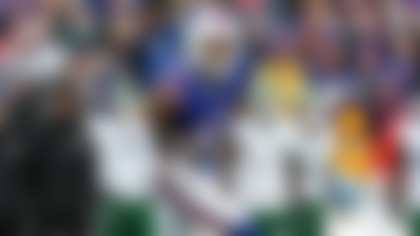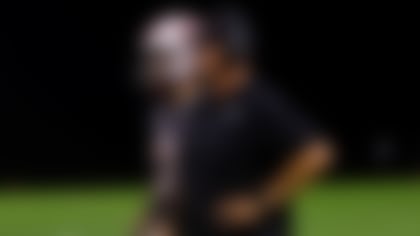After spending 12 years in the NFL as a player and scout, I've learned that the evaluation of the quarterbacks is the most difficult of all positions.
The position demands a unique set of mental and physical skills that are sometimes difficult to assess strictly from viewing game tape.
To properly get a feel for a quarterback's potential, scouts will use a combination of game-tape evaluation and in-person viewing to examine his physical characteristics.
Those traits include his size, arm strength, athleticism and mobility. Scouts want to get a sense for the zip and velocity on his passes, and if his arm strength translates to the next level. While it is not necessary for a quarterback to strongest arm, it is imperative that he can make the basic "pro-like" throws like the deep out or come back to the sideline from the opposite hash. He also must show outstanding accuracy and ball placement, but putting the ball on the pass catcher's proper shoulder is one of the biggest skills that elite quarterbacks possess.
From a mental standpoint, scouts want to see the presence and poise that he displays in the pocket. If he is able to keep his composure when things break down around him, you come away convinced that he is able to handle the pressure that he will consistently face.
Scouts will also look at a quarterback's anticipation, awareness and decision-making to see if he has the moxie to be successful against the complex coverage that he will certainly see on the next level.
In looking at this year's quarterback class, the prevailing concern revolves around their collective ability to transition to the pro game. Most operated spread offenses that featured the shotgun formation and a host of dink-and-dunk routes that led to gaudy production. The unique difference between the spread offense and conventional systems used in the pros makes projecting the group's NFL prospects extremely difficult.
Let's take a look at the challenges scouts have in assessing this year's crop of quarterbacks:
Cam Newton, QB, Auburn
He emerged as the most electrifying player in college football while leading Auburn to the BCS title in his only season with the team. At 6-foot-4, 253 pounds, he has the size that offensive coordinators covet in an ultra-athletic package. His running ability and improvisational skills make him a weapon on the perimeter, but he is more than a run-first QB. He possesses an exceptionally strong arm, and shows solid throwing mechanics in the pocket. Although his sloppy footwork led to some errant throws, he has dramatically tightened up his fundamentals over the past three months and shows the potential to be an effective drop-back passer.
When looking at the challenges evaluators have in making Newton's evaluation, forecasting his transition from the spread to a pro-style system is the biggest concern. The footwork and vision on conventional drops is completely different from the shotgun, so scouts must determine if he can smoothly acclimate to working from under center. They must also determine if he can adjust to the nuances of a complex offensive system that is vastly different from what he directed at Auburn. Throw in his relative inexperience (only 14 career starts), and it's easy to see why scouts view him as a risky proposition despite his immense potential.
Blaine Gabbert, QB, Missouri
He is regarded as one of the best pure passers in the draft based on his arm strength and throwing mechanics. He has velocity on his passes, showing accuracy and placement on all short and intermediate throws. He flashes anticipation, awareness and timing while throwing to open receivers against tight zone coverage. Although his penchant for throwing into small windows occasionally leads to interceptions, his aggressiveness and instincts are on par with the NFL's elite quarterbacks.
In breaking down the concerns that scouts have in Gabbert's game, like Newton, transitioning from a spread offense to a pro system tops the list. Gabbert spent nearly all of his time working from the shotgun at Missouri, and he must show he is comfortable working under center.
The footwork and mechanics that he displayed in workouts helped answer that question, but he must continue to demonstrate he can diagnose complex coverage in private meetings and workouts with teams. He also must prove that he can make deep throws with touch and accuracy. His completion percentage dipped dramatically on throws over 15 yards, so he has to consistency connect on those tosses in workouts.
Ryan Mallett, QB, Arkansas
He is regarded as the most NFL-ready in the class after spending two seasons directing Bobby Petrino's pro-style offense. At 6-5, 255 pounds, he is a conventional drop-back passer with physical tools. He has exceptional arm strength, and delivers the ball with zip. He illustrates accuracy while pushing the ball down the field, and is a perfect fit in an offense that features the vertical passing game. Mallett's experience directing the game from the line of scrimmage puts him slightly ahead of the competition due to his familiarity with hot reads, sight adjustments and checks.
In a normal situation, Mallett would likely rank at the head of his class based on his talent, but scouts have been grappling with a few issues that keep him from earning that distinction. He is regarded as a sitting duck in the pocket based on limited athleticism, and scouts wonder if he has the mobility to elude rushers. His on-field woes are considered a minimal concern when compared to the leadership and character flaws that reportedly surround him. He has been described as immature by some evaluators. He was charged with public intoxication in 2009, and rumors of drug usage have also tarnished his reputation. He has received solid feedback for his interviews in front of team personnel so far, but must continue to show he is capable of handling the responsibility of being the face of a franchise.
Jake Locker, QB, Washington
He is one of the best athletes in the draft and his physical gifts had many touting him as the potential No. 1 pick in last year's draft. However, he elected to hone his skills another year at Washington and his overall game has shown improvement. He is an outstanding passer on the move, and his ability to run with speed and power makes him the ultimate weapon.
As a drop-back passer, he shows arm strength while making the requisite throws. His velocity rates near the top of the charts, and shows flashes of being a potential star. Throw in his leadership skills and intangibles, and there is a lot to like about Locker.
Still, as scouts pick apart his game, his accuracy from the pocket is a concern. He completed only 54 percent of his passes throughout his career. Dismal passing performances in a pair of big games last season against Nebraska led to more questions about his ability to win from the pocket. His footwork and mechanics were off in those games, and didn't look much better during the Senior Bowl.
Although he showed marked improvement at the NFL Scouting Combine and his pro day, there is a huge difference between performing well at a workout and thriving in game action. With only a few workouts left, Locker must hope that his game tape is good enough to convince scouts that he can make the proper adjustments as a pro.
Christian Ponder, QB, Florida State
He has been on a meteoric rise up draft boards after winning the MVP award at the Senior Bowl. He has been well schooled in a pro-like passing game at Florida State, and has shown the ability to seamlessly transition from under center to shotgun. As a passer, he has good throwing mechanics and fundamentals from the pocket. He sets up with balance and delivers an accurate ball with zip. He is underrated as a passer on the move, but creative coordinators will take advantage of his skills by occasionally using him on the edge on movement passes. Given his experience, he shows an understanding of identifying hot reads, sight adjustments and making proper checks at the line of scrimmage. These are important attributes that will certainly help him succeed at the next level.
Ponder's biggest obstacle to first-round status appear to be his checkered medical history. He has missed parts of the last two seasons battling various injuries (elbow and concussion in 2010 and separated shoulder in 2009). He answered some questions by working out well at the NFL Scouting Combine and his pro day. He was given a fairly clean bill of health by the league's medical personnel, which helped him avoid a medical re-check in Indianapolis. If he truly gets a passing grade from doctors, he might enjoy another surge in his stock.
Follow Bucky Brooks on Twitter @BuckyBrooks.




